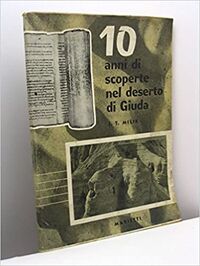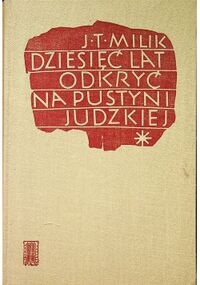File:1957 * Milik.jpg
1957_*_Milik.jpg (347 × 499 pixels, file size: 23 KB, MIME type: image/jpeg)
Józef T. Milik, Dix ans de découvertes dans le Désert de Juda (Paris [France]: Cerf, 1957).
Italian ed. (1957) : Dieci anni di scoperte nel deserto di Giuda
English ed. (1959) : Ten Years of Discoveries in the Wilderness of Judaea
Polish ed. (1968) : Dziesiec lat odkryc na pustyni judzkiej
Abstract (French Edition, 1957)
The title of Milik’s Ten Years of Discovery in the Judean Wilderness (1957) suggests that the book focuses only upon the discoveries, with all of the plot twists and intrigues that they entailed. Although Milik spends the first two chapters discussing the discoveries and the texts of the Qumran library, and a final chapter discussing the significance of the discoveries, the heart of the book is a history of the Essenes. Milik utilized the Qumran writings, classical authors, Josephus, and archaeological evidence to establish the parameters of Essenism. Milik was one of the early advocates of the Essene Hypothesis, identifying the Essenes with the inhabitants of Qumran. Milik suggests that the final phase of the Essene community had militant Zealot characteristics. Even though this text was written in the early phases of Qumran studies, it still contains valuable insight into the character and history of Essenism.
Italian ed. (1957)
"Questo fascicolo di Józef Tadeusz Milik, scritto a richiesta del sottoscritto, ma che esce contemporaneamente in varie altre lingue, adempie alla funzione .. di fare il punto con una sicurezza di risultati e autorevolezza di proposte particolarmente notevoli. Il giovane autore, sacerdote della diocesi di Varsavia, nato nel 1922, compì al Biblico di Roma i suoi studi semitici iniziati all'Università Cattolica di Lublino in Polonia. A Roma pubblicò i primi studi sui manoscritti [di Qumran], oltre altri lavori sull'epigrafia semitica e archeologica, alcuni in lingua italiana, che gli valsero la chiamata a Gerusalemme (1952) per lo studio diretto dei manoscritti stessi. Da allora egli partecipa alle esplorazioni nella regione delle scoperte e agli studi per la pubblicazione dei manoscritti: nell'attività occupa ormai una parte di primo piano, alle dipendenze dell'Ecole biblique et archèologique française dei Domenicani di Gerusalemme e come membro incaricato (dal 1954) delle ricerche per conto del Centre National de la Recherche Scientifique di Parigi. .. In questo fascicolo l'autore mostra una capacità che ancora non si conosceva nella sua produzione: la sintesi. Tutti gli aspetti del problema qumranico sono toccati, sempre con dati sicuri, come ci si può attendere appunto da un conoscitore diretto del campo e spesso con viste personali che l'autore stesso non intende proporre che a titolo di ipotesi probabili, buone a comprendere fatti finora o non osservati o rimasti senza spiegazione e che almeno possono essere proposti come temi di ulteriore ricerca..."--Prefazione (Giovanni Rinaldi)
English ed. (1959)
"J.T. MILIK was a Polish priest who, after brilliant studies in Rome, worked in Jerusalem from 1952, first at the Ecole Biblique et Archeologique Francaise, and later in connection with the Centre National de la Recherche Scientifique. He took part in the exploration of the Qumran. From the beginning, he collaborated in the work of publication. With Father D. Barthelemy he published the fragments from Cave I, Qumran Cave I (Discoveries in the Judaean Desert), Oxford 1955; he was the most active member of the international team, which prepared for publication the considerable collection from Cave IV. The fragments from Cave V and the copper rolls from Cave III were entrusted to him. He would eventually publish the Hebrew and Aramaic documents from Murabba'at; he published some fragments from Hirbet Mird and from unidentified caves in the south. He had been given direct access to all the documents still unpublished, which were kept together in the Palestine Archaeological Museum in Jerusalem. In short, this work was written by a specialist who knew better than anyone the places and documents of which he spoke."--Publisher description.
Contents
- I. The Story of the Discoveries
The first manuscript cave of the Qumran area (1Q) -- Discoveries at Murabba'at Caves II and III at Qumran -- Hirbet Mird and a cache from the Second Revolt -- Qumran Caves IV, V and VI -- Qumran Caves VII-XI and a new cave at Murabba'at
- II. The Qumran Library
How the scrolls were written -- Biblical manuscripts: The Torah, The Former Prophets, The Latter Prophets, The Writings -- The Hebrew of the biblical text: new data -- The Deutero-canonical books or Apocrypha -- The Old Testament Pseudepigrapha: Jubilees, The Book of Enoch, The Testaments of the Twelve Patriarchs, Other Old Testament Pseudepigrapha -- Sectarian literature: The Rule of the Community, The Damascus Document, The Rule for the War; the Hymns -- Commentaries on the biblical books -- Other writings found at Qumran
- III. History of the Essenes
A text from Pliny -- The exploration of Qumran -- Description of the ruins -- The phases of occupation at Qumran -- Qumran and the Essenes -- The evidence of the Qumran texts -- The Damascus Document -- 4Q Testimonia -- The Habakkuk Commentary -- Other allusions -- The Teacher of Righteousness -- Synthesis -- Conclusion
- IV. Essene Organization and Teachings
The hierarchy -- Admission of new members -- Ora et labora -- The sacred banquet -- The calendar and the feasts -- The True Israel and the New Covenant -- The two spirits -- The spiritual life of the Essenes -- The eschatological war -- The two Messiahs
- V. The Discoveries in the Judaean Wilderness and their Importance
Documents spread over two thousand years -- The linguistic importance of the discoveries -- Palaeography -- Historical and onomastic importance of the texts -- Legal importance of the texts -- The Qumran texts and Hebrew literature -- The discoveries in the Judaean Desert and the history of religions
Chronological Table -- Bibliography -- Additional Notes -- Index of Subjects -- Index of Passages Cited
Polish Edition (1968)
External links
File history
Click on a date/time to view the file as it appeared at that time.
| Date/Time | Thumbnail | Dimensions | User | Comment | |
|---|---|---|---|---|---|
| current | 17:30, 16 January 2022 |  | 347 × 499 (23 KB) | Gabriele Boccaccini (talk | contribs) |
You cannot overwrite this file.
File usage
There are no pages that use this file.



